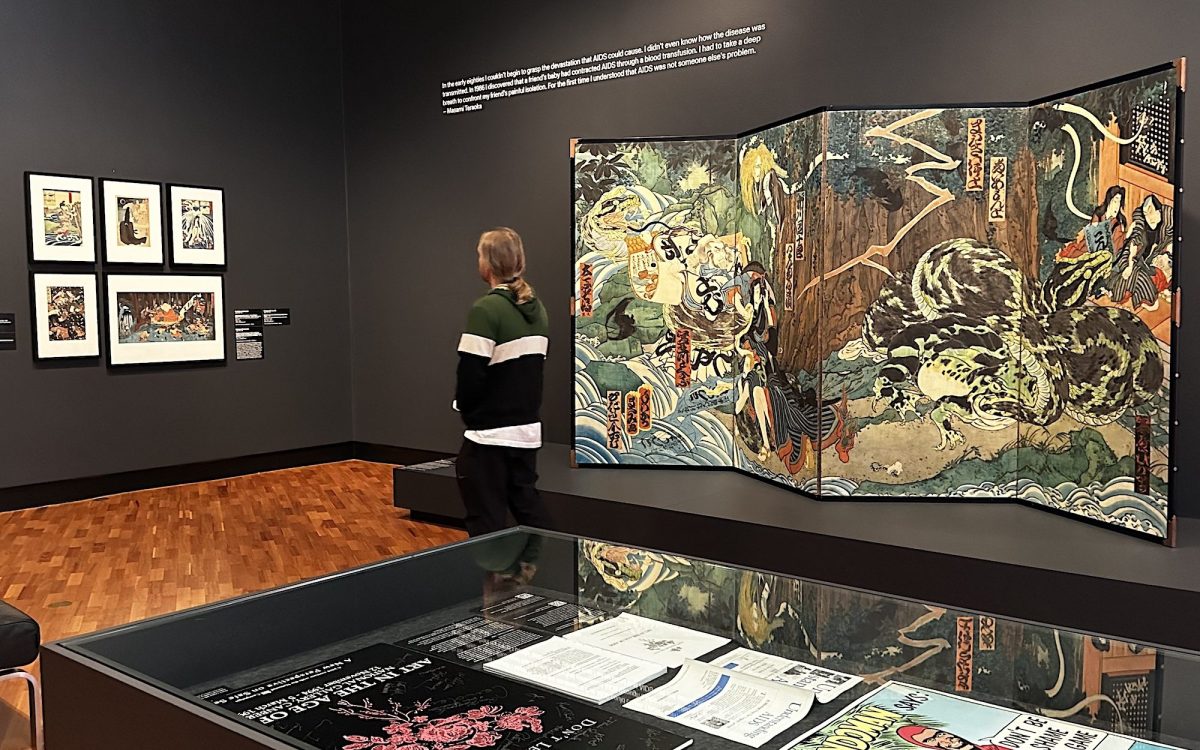The National Gallery of Australia’s (NGA) holdings of international prints is deep and rich, but we don’t always get to see them. Its current exhibition Masami Teraoka and Japanese Ukiyo‑e Prints is a great example of making sense of those holdings.
Teraoka is a master printmaker of Japanese-American heritage. His images have become iconic for the way they fuse historic touchpoints with contemporary culture, such as McDonald’s Hamburgers Invading Japan/Tattooed Woman and Geisha III (2018), which the Gallery acquired in 2023.
He started to find his visual vocabulary in the early 1970s, after moving to Los Angeles in 1961 in the early days of the sexual revolution. Growing up in Japan in the 1930/40s, his reference points were 17th to 19th century ukiyo‑e woodblock prints (Edo period). But moving to the US opened his eyes to a global culture – one that was dealing with the AIDS crisis, globalisation, consumerism and an East meets West collision.
This exhibition walks visitors through these different concerns, or phases, across Teraoka’s work, starting with his nod to the ukiyo‑e genre of shunga (erotic prints). Indeed the first work seen is by ukiyo-e master Torii Kiyonaga, titled Shunga (c 1785), consisting of six stacked images, like a scroll that has been spliced into erotic fragments.
Teraoka’s Sarah and Octopus/Seventh Heaven (2001), sits within a grid of master works, allowing viewers to form those connections – in particular, to the famed woodblock master Hokusai. On the one hand it promotes age-old sexual liberation, while on the other offering a warning of safe sex.
This starts to make sense in the context of the exhibition, which coincides with the 30th anniversary of the National Gallery’s pioneering exhibition, Don’t leave me this way: Art in the age of AIDS (1994), which featured Teraoka’s art.
Forming the bookend of the show, is a suite of works in the second gallery on the topic. Teraoka used the ukiyo‑e genre of yūrei‑zu (supernatural beings), and elements of Kabuki theatre, to capture the tone of the AIDS pandemic, their narratives signalling demonic warnings.
One of his most celebrated pieces from this period is a folding screen, AIDS Series/Makiki Heights Disaster (1988), which was acquired by the Gallery last year and is a highlight of the exhibition. Teraoka created it as a cautionary narrative – a woman tries to convince her partner to use a condom – and is used in the same way as ancient prints to teach how to navigate life. It is just as current today as it was in the 1980s.
This section of the exhibition also includes ephemera in a display case relating to the 1994 exhibition, along with associated activists’ works, and a stunning Kabuki robe.
A sure pleasure for viewers will be Teraoka’s take on the ukiyo‑e genres of bijin‑ga (beautiful women), and his Hawaii Snorkel Series, published by Tyler Graphics in 1992-93. It is presented with a vitrine of related trial proofs and archival materials, that give viewers a better idea of “the hybrid techniques and innovative approaches Tyler employed to help Teraoka realise his vision,” explains the Gallery.
Read: Exhibition review: Cats & Dogs, The Ian Potter Centre: NGV Australia
Overall, this is not a static print show – there are costumes, ephemera annd objects. It is the first time that Teraoka’s works have been exhibited in depth by the NGA, or any Australian institution, and it offers an easy entry point to this important era of Japanese woodblocks and culture – both its historic foundations and contemporary inflections.
A lovely exhibition to pass an hour with.
Masami Teraoka and Japanese Ukiyo‑e Prints
National Gallery in Kamberri/Canberra
21 September 2024 to 2 March 2025
Free.





